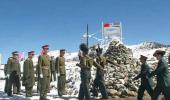The Indian Army has been slow to react.
Indian troops have deployed in the vicinity of PLA incursions, but there are no attempts to outflank Chinese positions.
Ajai Shukla reports.

In June 2017, Indian soldiers in Sikkim took Chinese border guards completely by surprise when they crossed into Bhutan and physically blocked the Chinese road construction crew from extending a track into disputed territory.
Eventually, hundreds of Indian soldiers stood face-to-face with as many Chinese for over two months, before New Delhi and Beijing negotiated a mutual withdrawal that saved face for the Chinese.
Today, it is the Indians who have been taken by surprise.
In the third week of April, Indian border forces in Ladakh observed regular Chinese forces on the Line of Actual Control the de facto border -- being supplemented with additional troops, heavy trucks, and equipment. The Indian side mistakenly assessed this was just routine summer training.
There was a shock on May 5, when some 5,000 Chinese troops crossed into the Galwan River valley, followed by another incursion in similar numbers into the Pangong Lake sector on May 12.
Simultaneously, there were smaller incursions near Demchok in southern Ladakh, and in Naku La in north Sikkim.
Government sources assess there are close to 10,000 soldiers of China's People's Liberation Army in Indian territory.
Dialogue is frozen, with the Chinese rebuffing Indian calls for flag meetings to resolve the situation.
The most worrying situation is in the Galwan valley where the PLA has crossed China's own claim line (which Beijing had stated was the border with India), and breached 3 to 4 km into Indian territory.
PLA troops are digging defences to equip themselves to face any Indian attack.
A Chinese defence Web site with close links to the PLA has claimed that the Galwan River Valley is a part of China.
Stating that the Indian side crossed the line in the Galwan Valley... and unilaterally change the status of the border, the Website claimed: 'The Galwan Valley is Chinese territory, and the local control situation is very clear.;
This follows a previous pattern. China had systematically eroded Galwan's status starting 1956, followed by an official claim in 1960, and then by military action during the 1962 War.
The border at Galwan River was first enunciated by China in a map published in 1956, and endorsed by (then Chinese premier) Zhou Enlai in 1959.
In that, China claimed a boundary that started east of the Karakoram Pass and ran south-east, cutting through the Galwan River Valley to Khurnak Fort.
From there it ran south through the centre of the Pangong Lake, passing through the eastern extremity of the Spanggur Lake and then, further south to Demchok.
In 1960, when Zhou Enlai led an official delegation for talks to New Delhi, China advanced a new border that claimed an additional 5,180 sq km of Indian territory in Ladakh.
Running generally west of the 1956 claim line, it ran close to the eastern bank of the Shyok River, cutting the Galwan River close to its confluence with the Shyok -- west of the earlier claim.
Further south, it claimed more of the Pangong Lake, all of the Spanggur Lake, and then ran approximately along the 1956 claim line to Demchok.
During the 1962 War, Chinese troops captured the Galwan Valley post, killing some 36 Indian soldiers.
After the war, China advanced its claim line further west, claiming an additional 2,000 sq km of Ladakh.
Now, even this claim line has been violated and China is attempting to push the frontier at Galwan further west.
Four days after the Galwan intrusion, China's second intrusion began on May 9 in Naku La, also across a settled Sikkim-Tibet border.
Some 200 Chinese soldiers temporarily occupied Indian territory, but have now withdrawn to the Chinese side and have pitched tents.
In the third intrusion, which took place near the Pangong Lake on May 12/13, thousands of Chinese soldiers occupied disputed territory between Finger 8 and Finger 4.
By May 18, the Chinese had taken over the so-called Finger Heights.
While this intrusion is not into territory that Beijing has previously recognised as Indian, there is now -- for the first time -- a Chinese flag flying on the hill overlooking the lake.
India's so-called Dhan Singh Post, which was built after the 1962 War, is the last Indian post standing in that sector.
The Indian Army has been slow to react. Indian troops have deployed in the vicinity of PLA incursions, but there are no attempts to outflank Chinese positions.
One-two Indian brigades have begun moving into the area over the past week.












 © 2025
© 2025